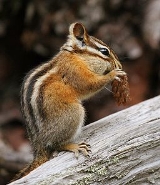
Chipmunk
Overview
Squirrel
Squirrels belong to a large family of small or medium-sized rodents called the Sciuridae. The family includes tree squirrels, ground squirrels, chipmunks, marmots , flying squirrels, and prairie dogs. Squirrels are indigenous to the Americas, Eurasia, and Africa and have been introduced to Australia...
s native to North America
North America
North America is a continent wholly within the Northern Hemisphere and almost wholly within the Western Hemisphere. It is also considered a northern subcontinent of the Americas...
and Asia
Asia
Asia is the world's largest and most populous continent, located primarily in the eastern and northern hemispheres. It covers 8.7% of the Earth's total surface area and with approximately 3.879 billion people, it hosts 60% of the world's current human population...
. They are usually classed either as a single genus
Genus
In biology, a genus is a low-level taxonomic rank used in the biological classification of living and fossil organisms, which is an example of definition by genus and differentia...
with three subgenera, or as three genera
Genus
In biology, a genus is a low-level taxonomic rank used in the biological classification of living and fossil organisms, which is an example of definition by genus and differentia...
.
Chipmunks are usually classified either as a single genus, Tamias, or as three genera: Tamias, containing the eastern chipmunk
Eastern Chipmunk
The eastern chipmunk is a small squirrel-like rodent found in eastern North America, the sole living member of the chipmunk genus and subgenus Tamias....
; Eutamias
Eutamias
Eutamias is a genus of chipmunks within the tribe Marmotini of the squirrel family. It includes a single living species, the Siberian chipmunk . The genus is often treated as a subgenus of Tamias, which is now restricted to the eastern chipmunk of North America...
, containing the Siberian chipmunk
Siberian Chipmunk
The Siberian chipmunk or Common Chipmunk is a chipmunk which occurs across northern Asia from central Russia to China, Korea, and Hokkaidō in northern Japan. The only chipmunk found outside North America, it is classed either as the only living member of the genus Eutamias, or a member of a genus...
; and Neotamias
Neotamias
Neotamias is a genus of chipmunks within the tribe Marmotini of the squirrel family. It contains 23 species, which mostly occur in western North America...
, containing the 23 remaining, mostly western, species. These classifications are arbitrary, and most taxonomies over the twentieth century have placed the chipmunks in a single genus.
Unanswered Questions

